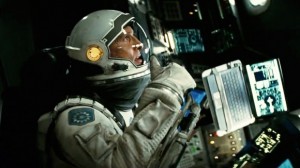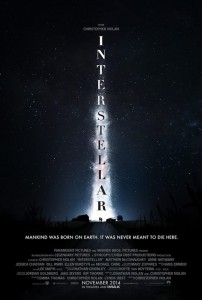Directed by Christopher Nolan, written by Christopher and Jonathan Nolan | Netflix
Steven Spielberg reportedly once said if he could go back he’d change the ending of Close Encounters of the Third Kind. Once Spielberg had kids, he realized the Richard Dreyfuss character, Roy Neary, would never have left his family behind to go into space with aliens.
Interstellar is the resetting of that dynamic, where the importance and future of kin is directly related to the decision to head… out there.
There’s a lot about the movie that reminded me of Spielberg, who was at one time attached to this project: a sense of wonder and hope around exploration, an appreciation of down home Americana, and a positive feeling for the metaphysics of the human heart. This is a warmer and fuzzier Christopher Nolan than we’ve seen before.
But most directly, this is Nolan’s stab at making an existential epic on the scale of Stanley Kubrick’s 2001: A Space Odyssey. And though he and his co-writing brother Jonathan’s ambition don’t quite reach those lofty heights, it’s a real pleasure to watch them make the attempt.
McConaughey is Coop, a test-pilot-turned-farmer in the post-climate change future trying to raise a teenaged son and daughter. America is a dustbowl, crops are failing. The human race is on its last legs, living through a “caretaker generation,” but Coop misses the days when we still looked out at the stars and dreamed of visiting other worlds, rock-strewn alien surfaces that look a bit like Iceland, on which to plant Old Glory.
Well, hold on to your hat, because forces are at work to send Coop back to NASA and put his ass on a rocket through an allegedly alien-constructed wormhole, providing humanity a last ditch attempt to find a planet to colonize—and presumably destroy just as we’ve done this one. These kinds of missions provide plenty of opportunity to intone that Dylan Thomas poem, the one about “raging against the dying of the light.”
Time is the real issue here. The basics of relativity are such that once he’s through the wormhole and when he gets back to Earth, if he does at all, Coop’s kids will be all grown up (from Timothée Chalamet and Mackenzie Foy to Casey Affleck and Jessica Chastain, respectively) while he won’t have aged much at all. His daughter (unfortunately named Murphy) resents his going, but it doesn’t stop him. Nor does a mysterious morse code from beyond telling him to stay she detects from behind her bedroom bookshelf.
The dustbowl setup takes awhile, but once the mission is underway things really swing. The spacecraft through the wormhole idea is planned by Nolan’s good luck charm, NASA rocket scientist Michael Caine, and the mission crew includes Caine’s daughter, astronaut Anne Hathaway, along with Wes Bentley and David Gyasi. If you’re counting, that makes two father-daughter stories going on here. You’ll recall what I said about the Nolans’ ambitions—never just focus on a single, simple plot dynamic when two or more complex options might be available.
I’d also be remiss here if I didn’t mention an earlier Matthew McConaughey picture, the unjustly unloved Contact, which shares a lot of that eye-widening, galaxy-traversing awe with Interstellar, along with the eye-dampening father-daughter relationship. There’s a scene in Contact where—just following one where one of the possible candidates for interstellar travel begs off because his son asks him not to go—McConaughey explains relativity of time and space travel to Jodie Foster’s Dr Arroway. When McConaughey read the Nolan brothers’ script for Interstellar, it must have seemed very familiar. “Wanna take a ride?”
There are plenty of dualities going on there as we travel through time, tromp through multiple episodic segments, and even crosscut between events on four planets in two galaxies to get through the full 169 minute picture, one that barely lags. In that regard, Interstellar shares a lot of deft juggling with Nolan’s brilliant dreamscape heist movie Inception, and as with Inception, some of the science is, let’s say, creatively licensed.
For instance, during Inception I wasn’t really bothered by the idea that time moves at a different rate in dreams (which it actually doesn’t), and in Interstellar I didn’t really mind that two separate mathematical equations are sought and five dimensions are considered without clearly explaining how any of it will directly benefit humanity. Your light years may vary.
So, while occasionally my head was scratched, I really enjoyed where the movie took me—on the waves of Hans Zimmer’s terrific, hypnotic and sometimes overpowering score and through Hoyte Van Hoytema’s many 70mm and IMAX lenses. I saw it in an IMAX theatre and the scale of the film is jaw-dropping (and, sometimes, eardrum rattling).
I wanted to bring this discussion back to Kubrick, because there are so many blatant and playful homages to 2001.
The first is an almost throwaway joke: the world has gone so Luddite the new editions of the history books have recorded the Apollo moon missions were faked, which, of course, Kubrick was rumoured to have had a hand in.
Then there’s the “Blue Danube” moment, which, yes, includes a rotating spacecraft and beautiful, all-encompassing silence.
The wormhole-penetrator does utilize onboard chatty, intelligent computers a la Hal, two of them here, though the scifi geek in me has to mention that TARS and CASE are the most awkward, clunky-looking robot helpers since Huey, Dewey, and Louie, the walking gas pumps from Silent Running. Nolan is too clever a filmmaker to not have based these robots on some kind of plausible design, but aside from TARS’ sense of humour, I wasn’t really buying them or their abilities.
I think what separates Kubrick from Nolan is Kubrick was OK with his audience not getting the big ideas. He just put them out there and let us figure out the puzzle. With 2001, huge chunks of the film was only music and image, challenging us to react both intellectually and emotionally with the work.
Nolan (and his brother), while glossing some key plot points, too often feel the need to over-explain the philosophy, adding clunky exegesis. For guys as smart as they are, it’s a real shame they don’t trust their audience more and just let the imagery and music communicate for them.
Speaking of that, we do eventually get a sequence deep in the third act where the movie (having passed Jupiter much earlier) goes “beyond the infinite” and asks us to go with it. The visual representations of these ideas—as well as how the wormhole and a black hole are depicted—are wonderfully vertiginous, not entirely unlike the ones witnessed by David Bowman in 2001.
I appreciated the visions in both 2001 and Interstellar, pushing the limits of special effects and challenging the imagination. But maybe because Bowman wound up saying a lot less than Coop, Kubrick’s a little more.








